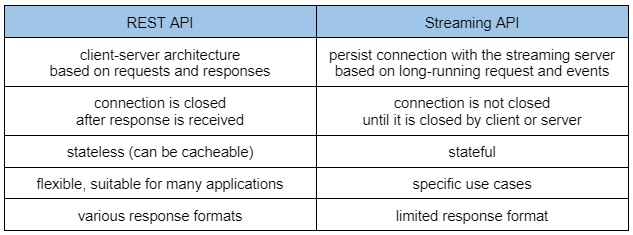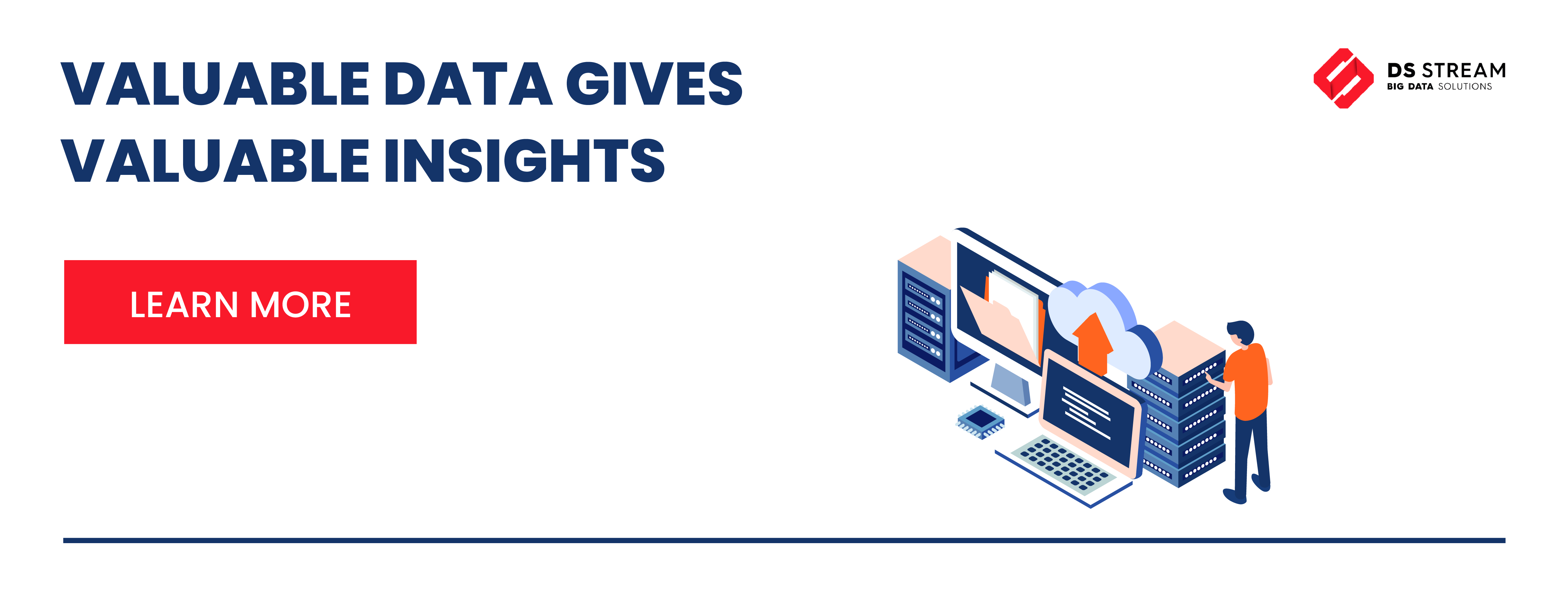
-
8 December 2022
- Big Data
Application development is a more complex process than some might imagine. Among the important choices you have to make, there is also the choice of API architecture – Streaming API vs REST API. Do you know which one is the best option for your app? We’ll explain the differences between these two. Read our article here.
API allows applications to communicate. As you’ve probably figured out on your own already, it is a significant element of an app. The topic of APIs in general is quite wide – what you need to know in the beginning is that there are many architectural types. If you’ve decided to develop your application with an external team of experts instead of in-house, they will probably advise you on the best solution. Still, making the final choice is always up to you, and it would be wise to know something more about the available API approaches. In this article, we are going to compare Streaming API vs REST API.
What is an API?
API stands for Application Programming Interface. It is a piece of software that enables two applications to “talk to each other”. In other words, an API allows an application to exchange data, which means that we use it almost all the time when we request some information while using apps on our devices or sending messages. The process of exchanging data consists of a few steps:
- A user performs some action using an application.
- The app connects to the Internet and sends information to a server.
- The server receives data and interprets the request.
- The server performs all actions necessary to send the right results back to the app.
- The application also interprets and visualizes the received data in a readable format (text, image etc.).
This is all done by means of the application’s APIs. When it comes to the apps we all use on a daily basis, processing a single request often takes less than a few seconds.
REST API – what do you need to know?
“REST” means Representational State Transfer. REST APIs run in client-server architecture and the flow of information in client-server relation is simply a request-response paradigm. What does that mean? First, a client/user requests something (information or an action) from an app, and then the server responds by performing the request (completing some actions or providing a user with information) – just as it was described above.
But why is it “REST” API? Well, RESTful APIs are stateless, which means that they don’t keep any user context on the server, except for information indispensable for the user’s authentication and for performing the current request. Still, REST APIs can store data related to previous requests and present it to the user whenever it is requested again, hence we can call them cacheable.
REST APIs are highly scalable and flexible, and they are widely applied in digital products of all types. Because this type of API is built around a request-response model, it is mostly leveraged in projects where the end user requests a wide range of calls, and where the server has to respond with some variety of data. For example, it is used in applications for comparing prices of services (car rentals, hotels, flights, etc.). In fact, REST API can be used in numerous types of applications, but there are a few projects in which this solution would be insufficient.
What is Streaming API used for?
Streaming APIs are totally the opposite of REST APIs. They are simply a long-running request, left open, so data can be pushed into it. When they are updated, the user is provided with the results. These APIs are used for reading data in real time from the web and provide users with precise and up-to-date information. In contrast to REST APIs, Streaming APIs are stateful. They have to store state (data) in some form, otherwise they would be incapable of properly putting together data with the request.
While this solution may seem quite advanced and powerful at first glance, it is actually less flexible in terms of content compared to REST API. A Streaming API has a strongly limited response format, so it would be impossible to receive the desired outcome in some cases.
The question is not really if Streaming API can be an alternative for REST API, but rather what the best applications are for each of them. As they are almost exact opposites, it is a natural conclusion of a comparison of Streaming API vs REST API that they support opposite use cases. Streaming API is recommended in applications leveraged by users to request unique, formatted data from a server. One example of Streaming APIs can be those used by social media platforms (e.g. Twitter and Facebook), which provide users with real-time data by updating information automatically.
Streaming API vs REST API – essential differences
The most important differences you have to remember are:
- REST API leverages client-server architecture. Hence a user makes a request and the server responds with the information that the user needs. Streaming APIs updates, on the other hand, are sent to the user immediately as events occur.
- Streaming APIs are stateful, and REST APIs are stateless (which means that the API itself saves no client context, except for the initial request).
- Streaming APIs HAVE TO store the state in some form in order to properly interpret the data correlation with the user that requests them. REST APIs are cacheable. They CAN store data that has been requested and present it to the user later.
- REST APIs have multiple applications as they are very flexible and highly scalable. They are used in many types of applications. At the same time, Streaming APIs are not as flexible, but in some specific situations they can be a perfect solution for a particular application.
Using a REST API is sometimes compared to a conversation, while making requests with Streaming APIs is more like watching a film.

How to choose the best API for your project
The process of selecting the right tech stack, architectural approach and other solutions depends strongly on the problems that your application has to solve. Before you pick, you should do several things:
- Consider the key functionalities of your application and find the API types that will allow your app to serve its purpose efficiently.
- Think of less important functionalities your digital product should have, and about those you want to add later. Which of the APIs might not be suitable for covering your project requirements (now or in the future)?
- Discuss potential solutions in-house and with some experts outside your company. Don’t be afraid to consult many professionals about your choices. There are people in the industry that may have considerable experience on that topic because they have participated in multiple projects. It would be a shame not to benefit from their knowledge.
Finally, select the most optimal solution for your app.
RESTvs Streaming API – summing up
Having easy access to real-time data is one of the main advantages of some applications. Immediately providing users with expected and accurate results is an important value for many app users. It is rather obvious, as well, that real-time data updates can significantly improve user experience.
Those two APIs are different in terms of architectural solutions and use cases, of course. It may be difficult to make the choice when it comes to designing your own application. We will be happy to examine your project and suggest the most suitable type of API. Contact us and tell us more about your ideas and doubts.
Check out our blog for more details on Big Data:


